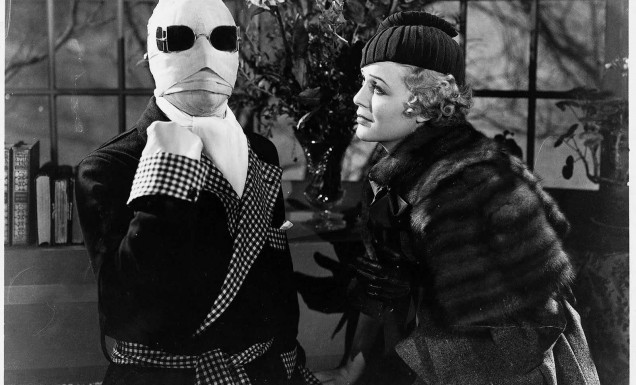The Invisible Man
horror, USA, 1933
DIRECTED BY: James Whale

CAST:
Claude Rains (Dr. Jack Griffin aka The Invisible Man),
Gloria Stuart (Flora Cranley),
William Harrigan (Dr. Arthur Kemp),
Henry Travers (Dr. Cranley),
Una O'Connor (Jenny Hall),
Forrester Harvey (Herbert Hall),
Holmes Herbert (Chief of Police),
E.E. Clive (Constable Jaffers),
Dudley Digges (Chief Detective),
Harry Stubbs (Inspector Bird),
Donald Stuart (Inspector Lane),
Merle Tottenham (Millie)
SCRIPT:
R. C. Sherriff
PHOTOGRAPHY:
Arthur Edeson
MUSIC:
Heinz Roemheld
EDITING:
Ted Kent
Synopsis:
One snowy winter night, an unusual stranger arrives at the small Lion's Head inn in the provincial English village of Iping in Sussex. His head is completely wrapped in bandages and his eyes are hidden behind dark glasses, and he demands that the owner of the inn and everyone else leave him alone.
Sometime later, innkeeper Hall's wife hires him to chase down the mysterious stranger, since he's late on his rent and has made quite a mess of the room while doing some research of his own. Angry that he is being disturbed, the stranger physically fights with the innkeeper and throws him down the stairs, and when a policeman arrives soon accompanied by several locals, the man takes off his bandages and glasses and reveals to everyone that he is invisible. Then they take off all their clothes, which makes him completely invisible, and he runs away to the village in front of his pursuers.
The invisible man is Dr. Jack Griffin, a chemist who, by conducting a series of tests that included taking a dangerous drug called Monocane, discovered the secret to achieving invisibility through a combination of circumstances. His fiancee Flora Cranley, who is also the daughter of Griffin's employer Dr. Cranley, is already very upset about Jack's long absence.
When Dr. Cranley and his assistant Dr. Kemp decide to search Jack's empty lab, they find only one paper in the cabinet. Its content is quite worrying, as it is a list of chemicals, including Monocane, the use of which can be extremely dangerous and can drive the user insane. It seems that Jack is not aware of this, but that he believes that these chemicals only have the power to kind of blend their user, that is, to turn him into an invisible man.
The fantastic horror The Invisible Man, directed by James Whale at the Venice festival in 1934, won a Special Recommendation, the screen adaptation of the very popular novel of the same name by H.G. Wells, who were translated into the screenplay by R. C. Sherriff (Zoltan Korda's Four Feathers, Sam Wood and Sidney Franklin's Goodbye Mr. Chips, Carol Reed's Fugitive), who, unsigned, collaborated with considerable success on the templates of genre-related works The Old Dark House, The Bride of Frankenstein and Dracula's Daughter, as well as the Oscar-winning Miss Miniver by William Wyler, and then still anonymous, and later extremely respected director and Oscar-winning screenwriter Preston Sturges (Hail to the Conqueror, The Great McGinty, Sullivan's Travels).
For the work in which the British actor Claude Rains appeared for the first time in Hollywood, and made a great impression, although his character is only visible for about half a minute, Whale himself claimed that it was his favorite film. Rains was hired after the role was turned down by Boris Karloff, who feared a wrong career move because he would not be seen in the film, but the striking voice of the British actor was quite enough to create an excellent role for which he will be forever remembered.
Although the adaptation is faithful to the literary template, Whale, in cooperation with the screenwriters, thoughtfully enriched the whole with a dose of camp, which is occasionally, for example in the scene where the inn owner's wife sees an invisible man, quite pronounced. The unconventional Whale and his collaborators have intelligently approached Wells' novel, in a serious way, but also with enough wit, with the director's usual eccentric humor perfectly suited to the prose of the writer who allegedly disliked the adaptation of his work precisely because of the comic details.
While the title character experiences various (mis)accidents, from stealing bicycles to breaking windows to outsmarting the police, the principled seriousness and tension of his condition and dramatic situations are constantly relativized and subverted by details such as him going to bed in his pajamas, breaking into someone else's house or dashing down the street with stolen trousers, while at the same time humming a happy song. Whale's playful style and inventive visuals are also impressive here, just like the extremely inventive and actually fascinating special effects for the time, with bicycles that drive themselves, with footprints that appear in the snow and with hands that light a cigarette in front of an invisible face smoke is billowing, and the excellent dialogues, which are undeniably among the best in the genre, should certainly be singled out.
The Invisible Man is not the first joint project between James Whale and head writer R.C. Sherriff, because the latter wrote the play that served as the basis for the director to realize his debut, the war drama Journey's End from 1930. At first, there was a possibility that Whale would not direct the film at all, because he was afraid that he would be classified exclusively as a horror director, so for a while Cyril Gardner appeared as the director, and Richard Schayer and the great John Huston were hired as screenwriters. But when Karloff dropped out of the cast, and accepted the role in Charles Brabin's The Mask of Fu Manchu, the project gained new momentum with Whale in the director's chair. In 1940, the film received a sequel entitled The Return of the Invisible Man directed by Joe May, but without Claude Rains and with Cerdwick Hardwick in the lead role and Vincent Price in the most important supporting role.
Text author: Josip Grozdanić
b/w, 71'